
|
|||||
Preparing for an EMP (Electromagnetic Pulse)See also: How to Survive a Nuclear War,Books About Survival in the Future Hard Times. This is a new page, still evolving, as of January 2017. Summary NEWAn Electromagnetic Pulse (EMP) is a short lived burst of electromagnetic energy which could (and probably would) bring modern civilisation to an instant end, literally within seconds. This type of EMP can be generated by exploding a nuclear warhead very high up in the Earth's atmosphere. So high up that the usual effects of a nuclear explosion (fireball, blast, and fallout) do no damage at ground level. However the EMP which is generated will destroy almost all unprotected modern electronic devices instantly. So high up that the EMP from just one nuclear detonation can cover an area the size of Australia. Yes all of it. The entire continent. This means that computers will no longer function, including those at the bank which store the amount of money in your account, and everyone else's account. This is a permanent problem as there's no way to restore function to these devices, which are now just useless trash. Plus, anything connected to really long wires (such as those which carry mains electrical power) will burn out electrically, perhaps even catching on fire and burning physically. Which means no more mains electricity. This also means no more mains water supply, since both electricity and computers are needed to run it. Same with the phone network and the internet, meaning that even if you had a shielded computer or phone which still worked, and you had electricity to power it, there would be nothing for it to connect to. Also no more sewage system after the gravity fed pipes and tanks fill up, and there's no electrical power to pump their contents through the rest of the system with. Cars are also likely to be affected and may completely stop functioning — the more modern the car (and the more computer circuitry it contains), the more likely it is to no longer run. Really old cars (pre about 1970) with mechanical ignitions (i.e. points) and mechanical fuel systems (i.e. carburetors) should still work. Within a few hours, frozen and refrigerated food will start to spoil, and within a few days nearly all of it will be inedible. This includes both your fridge at home and those at the shops. Since modern supermarkets hold enough food for about 3-4 days (even at normal buying rates, let alone panic "end of civilisation" buying rates), within a few days there would be nothing left to eat at the shops anyway. Who will refill the shelves when there's no functioning monetary system to pay the store staff and the truck drivers, no functioning mass communications systems to inform anyone of what to do, no working petrol pumps to fill the trucks (they're electronic), no water in the taps for the drivers (or anyone else) to drink to ward off dehydration, and the trucks themselves are likely to be undriveable? The technology to create a nuclear EMP like this has existed since the early 1960s, and been demonstrated to work in nuclear tests done by both the USA and USSR. It's definitely not science fiction, nor a fringe conspiracy theory with no basis in reality. An EMP can also be generated by a super-intense storm on the Sun. A solar EMP does not contain the component (known as E1) which instantly destroys microelectronics like a nuclear EMP. It does, however, have a very similar effect to the slow (lasting about a minute) magnetic pulse (known as E3) which destroys things connected to really long wires, and can fry the electrical power grid. Even that alone would be a massive disruption to modern society. It's possible to protect microelectronic devices from EMP by "shielding" them. Basically this means completely surrounding them by something that conducts electricity (e.g. a metal box). It has to go completely around the item — top, bottom, and on every side, so that electricity can flow through the shield in every possible direction all around it, with no gaps or seams that don't conduct electricity. The rest of this page covers these points in much greater detail... What's On This Page?Quick Facts Quick Facts
How Likely Is an EMP?With the breakup of the Soviet Union in 1991, and the end of the Cold War, the threat of global nuclear war (and nuclear EMP attacks) greatly diminished. After that, a lot of people stopped talking about nuclear war as a serious threat. The hype in the media about nuclear war that was characteristic of the Cold War period stopped. Now, over 20 years later, the threat has increased to levels similar to (or worse than) the Cold War days, yet few people realise this. Still, little is said in the media. This has been changing slightly in the last few years, with more news stories mentioning nuclear war and EMP — however I think it's fair to say that many people would be surprised by the picture below:
NEW: On the 26th of January 2017, the Doomsday Clock was moved from three to two-and-a-half minutes to midnight. Their official statement can be read here. Recent nuclear bomb tests by North Korea, such as in January 2016, increase the complexity of the situation. What Is An EMP?EMP stands for Electromagnetic Pulse. According to Wikipedia, an EMP is "a short burst of electromagnetic energy. Such a pulse's origination may be a natural occurrence or man-made and can occur as a radiated electric or magnetic field, or a conducted electric current, depending on the source". For the purpose of this web page, an EMP is such a burst which is strong enough to damage electronic devices over a large geographic area. The two possible sources (that I know of) for a large EMP like this are a nuclear weapon and a solar flare (also known as a Coronal Mass Ejection). As far as I know, non-nuclear EMP weapons can only affect a small local geographic area. Conversely, a single nuclear EMP could cover an entire continent of the size of Australia or the USA. A nuclear EMP can be just an ordinary nuclear warhead detonated very high up in the air (like a few hundred kilometres). These were tested in the early 1960s by both the USA and the USSR. Since then, EMP weapons have been engineered to further enhance the strength of the EMP. With a nuclear explosion at this high an altitude, there's no blast or heat effects felt at the earth's surface, and no mushroom cloud or nuclear fallout. People, buildings, and basically anything non-electronic remain unharmed. The effects of just one 1960s-technology nuclear EMP can be enough to permanently destroy much of the modern electronics over an area as big as Australia. Modern electronics (like microchips) are vastly more sensitive to EMP than the electronics which existed in 1962. Also weapons technology has greatly increased since then. A nuclear EMP contains three components, two of which do nearly all (or all) of the damage. The E1 component destroys unshielded static-sensitive devices like microchips. The E3 component affects really long wires, like power lines, and can destroy many critical components which make up the electrical power supply grid (i.e. your mains electricity supply, which powers devices plugged into the wall). A solar EMP is similar to the E3 component only of a nuclear EMP. Effects of an EMP Event on Modern CivilisationOur food and water supplies, communications, banking, hospitals, law enforcement, etc., all depend on the electric grid. Therefore after an EMP, these would instantly cease to exist in anything like their current form. By far the majority of easily available information from internet searches indicates that essentially all civilian computer networks and other high-tech electronic equipment are unprotected from EMP. And even that large sectors of the military are no longer protected to the extent that they were during the cold war (in the 1960s - 1980s). Note that the destruction of the computerised banking system would mean that, apart from cash, all money would instantly disappear. Even just this one single effect alone would obviously bring about very, very major changes to our way of life. The effects of EMP increase with both the sensitivity of the devices being considered, and the physical size/length of conductors (i.e. metal) within them. Generally, the more complicated the device is within a small space, the more sensitive. For example something like a CPU, i.e. Central Processing Unit, the "brain" of a computer on a single silicon chip, and many other types of computer "chips", have millions or even billions of transistors on a single piece of silicon a few centimeters or less in size. Devices like this are very highly sensitive to EMP. As a general rule, anything that is easily destroyed by static electricity (such as when you rub your shoes on a carpet and then feel a spark when touching something grounded) will be highly sensitive to EMP. When you do repair work on computers and other sensitive electronic devices, it's necessary to take special measures to avoid static shocks which can destroy the equipment you're working on. Generally speaking, all these types of devices will be instantly destroyed by an EMP. The only exceptions to this that I can think of is that, maybe, some devices that are physically small enough, and not connected to anything else by wires or anything else conductive, will be somewhat more resistant to EMP. An example is an electronically powered wristwatch: there is debate over how sensitive these are. Some people claim the small size means there will not be enough length of conductor inside the watch for a large voltage to develop, and this means the watch will be okay. I haven't seen any real test data on this, though a few people in forums have claimed they have worked on EMP testing and seen watches survive (and reset themselves to zero time, but still work afterwards), it was not clear what type or strength of EMP they were testing with. Presumably it was not an EMP from a nuclear bomb, and certainly it would not have been from a high yield nuclear bomb detonated high up in the Earth's atmosphere, which is the type that creates the most damaging EMP effects. The other thing that increases susceptibility is the length of conductors (e.g. wires) in the device. Something with long wires that connects to something highly sensitive (like a silicon chip) will be the most affected. Or something with truly extremely long wires like the electrical power grid or landline phone networks. There have been no tests of EMP effects from high yield high altitude nuclear weapons since the early 1960s. This is because to conduct such a test now (with the existence of modern electronics and our dependency on them) would destroy modern civilisation. How to Protect Against EMPIn the long term, the only way to be safe from the effects of a society-wide EMP is to be in a position where you can live without requiring anything much from modern civilisation. The rest of this section will focus on how you can protect some of your own electronic devices against an EMP. The short answer to this is to completely surround sensitive electronic devices by a layer of conducting material (e.g. metal) which does not electrically connect with the device. The technical term for this metal covering is a shield. To make shields more effective, more than one can be used, nested inside each other like Russian dolls. In this case it's important that each shield does not electrically contact (which usually means does not touch) the other shields. If the shields are well constructed, two or three layers (perhaps even one) should provide essentially complete protection. Small electronic devices can be protected by fully enclosing them inside a conducting material (which usually means any type of metal), that entirely surrounds the device on all sides and has no seams or breaks or gaps that are non-conducting, and that does not itself touch anything conducting on the device to be protected. The simplest way to achieve this for small devices would be to wrap in a plastic (insulating) bag and then wrap in a few layers of aluminium foil. More than one layer of shield can be made by doing this more than once, e.g. wrapping a radio in a plastic bag, wrapping with aluminum foil, placing this in another plastic bag, then wrapping that with another layer of foil, etc. Two layers of foil with nothing in between counts as one layer (but thicker, which may also help). There is no need to ground the shield, such as by attaching a wire from the shield to the ground/earth. Occasionally on the internet you'll come across claims that this is necessary, but Gauss' Law can be used to show that the electric field inside any hollow conducting shell is zero. The old style metal garbage cans work well, and are perhaps the easiest to obtain enclosure of this size. Most metal toolboxes and other types of metal boxes (e.g. safes) are not good shields, since the way the lid attaches to the body of the toolbox does not allow for the entire enclosure, on all sides, to be one continuously electrically conductive box. For the garbage can (or any shield) to work well, the lid must make complete contact with the rim of the can, all the way around. The most effective way to achieve this is to tape the lid onto the rim with electrically conductive tape (which is usually made from copper with a conductive sticky layer). One place you can find conductive tape is from guitar parts dealers, as it's used to shield the electronic control compartments of electric guitars (to reduce noise/hum). These garbage cans will still work without the tape, but will work better with it.
What's wrong with this picture? Here you can see here some items in the bin. There are EMP preparation articles on the internet showing people using these bins and making a cardboard lining for the whole bin. These photos show a bin where this has not been done. Which is fine, provided that things inside are arranged so that there's no electrical contact between the items inside and the sides of the bin. In this picture, the large torch and the box with "Dream" on it should be moved so that they're not touching anything.
Many other types of small metal boxes can be used, provided there is a continuous electrical connection all the way around the box, above and below and on every side. Biscuit tins work well, provided the lid makes complete electrical contact with the box. This is usually not the case for most biscuit tins as they come from the shops. But you can use sandpaper to remove the paint from around the rim of the box, allowing the lid to contact it. Sometimes you will also have to sand down paint from the inside edge of the lid. To add to the complication, this paint may not always be coloured, it could be a clear coat / varnish which looks like bare metal but is electrically insulating.
The best way to determine this is using a multimeter set to the resistance (i.e. ohms) scale or other resistance measuring device, or a continuity tester. There should be close to zero ohms of resistance between the lid and box.
Other metal boxes will or will not work depending on how completely the metal surrounds the entire space inside, and how completely the metal is electrically connected all the way around.
It's good to have many different shielded items and shields. Part of the reason for this is that it's quite likely that multiple EMP attacks may occur within a time period. If for example you only had one radio and one torch that still worked, the time you would most want to use them is also the time during which they would be most likely to be zapped by another EMP.
Note that any wires connected to the device(s) inside the shield, which go through the shield to the outside of the can/box/foil wrapping/etc, will completely negate the protection of the shield. If you have a very large budget, much larger enclosures can be constructed, such as rooms and even entire buildings, though this is out of the reach of most ordinary people. Note of course that the only comprehensive way to protect against EMP is to be as able to live without electrical devices as much possible. This would of course involve having a locally available water and food supply, etc., and not being too far away from your home (or somewhere you know you can find food and water without modern civilisation) when the EMP happened. What to Protect Against an EMP?Basically anything containing microelectronics, or semiconductor devices, that you want to keep working after an EMP event. This would include LED torches, battery charging equipment, and small radios as a high priority. Also any radiation monitoring devices you may have (since the chance of further nuclear bombs being detonated, which deposit nuclear fallout, would be hugely higher after an EMP than before). Batteries themselves are not sensitive to EMP and do not need to be shielded. Neither do old style bulb (non-LED) torches. Some expensive two-way radio gear may be relatively EMP resistant due to being manufactured to withstand strong electromagnetic fields generated by its radio transmitting circuitry. Solar panels are possibly sensitive (although there is conflicting information regarding this), which is clearly a problem for large ones mounted on your roof. Smaller ones which can fit inside a metal box (such as a large metal garbage can) can be easily stored in a way that will protect them. Small music players, laptop computers, etc. If you have it, night vision equipment. You could consider solar powered refrigerator. Around 30 watts. Which could run from two 20 watt solar panels, small enough to fit in a large metal garbage can. I haven't yet looked into how EMP proof the fridges would be. I'd assume they would be pretty EMP proof if they don't have any semiconductor electronics in them . What to Do: Simple StepsHere are some things you can actually do, beginning with the easiest and most closely resembling something that ordinary "normal" modern people would do in everyday life. Start a collection of physical paper books (not electronic ones), and print any e-books you wish to still be able to read after an EMP. This would include survival books, farming books, etc. Buy at least one (ideally a few) old fashioned bulb-style torches and plenty of batteries for them. If you have a small one you can keep it with you, e.g. on your bunch of keys, or in a handbag, in your car, etc. Also spare bulbs are a good idea, though less of a priority since the batteries will most likely run out first. Sometimes you can find quality brand-name ones quite cheap as most people now are interested in LED torches. The large rectangular 6 volt batteries as found in "Dolphin" style torches are good in that they don't really fit anything else, so your spare batteries probably going to still be there and not used up already by the kids remote control car or something else. However they seem to have a shorter shelf life than regular AA, C, and D batteries, based on the expiry dates I've seen printed on them which are usually closer to 5 years in the future than nearly 10 years for AA, C, and D cells. Buy a large roll, or a few smaller rolls, or aluminium foil, and packs of resealable plastic sandwich bags or other plastic bags. Keep them in the cupboard until you hear about escalating conflicts which may result in EMP attacks. Start to wrap some things in the plastic bags and then foil over the plastic, and keep in storage. You could keep things in the box they come with when sold new, and wrap that in foil (without plastic). If a device is completely plastic or other insulating material on the outside, you can wrap it directly in foil without needing an inner plastic bag. At least two or three layers of foil e.g. plastic then foil than plastic again then foil again, etc, is recommended. You can begin with LED torches. Cheap $5-10 ones will do fine. Or expensive ones if your budget allows it. The great advantage of LED torches over bulb torches is they are much more efficient in terms of light output vs. battery life. It's best not to keep the batteries inside the torch (or any device), in case they get left there for years and leak acid all over the inside of the torch. This is especially true of the cheap no-name brand batteries that come with many cheap electrical goods. Another good thing to have wrapped up is a small radio which has at least AM and FM. And keep batteries for it, but not inside the radio. AM is more useful than FM over long distances, especially at night. A really good thing to have at this point would be some dynamo powered devices (e.g. hand crank powered, where you wind a handle to charge it). And/or solar powered devices. Such as torches, small radios, and combinations which have torches and radios in the one unit. Some of these can also provide power to charge other devices (e.g. batteries or smart phones) by USB connections. Note that many of these will contain rechargeable batteries inside them, which will stop working after several years (5-10 years is typical, probably closer to 5). Some crank-powered devices will still work without the battery, but only while you're actually winding it.
Next to the collection you would add battery charging gear, and rechargeable batteries. The batteries themselves don't need to be shielded but the chargers, and probably also solar panels, do. You could also look for more solid metal boxes to use as shields. See the shielding section of this web page for more on what types of boxes, and how to remove any paint from where the lids and box rims touch. More to be added later... How to Tell if an EMP Has Just HappenedIf the power suddenly goes out, and that's the only symptom, it's probably just an ordinary power outage (blackout). It could also be a solar EMP although of course ordinary blackouts happen much, much more often. If the power goes out and at the same instant, all (or most of) the portable, unplugged battery operated electronic devices you can see also black out, that is much more ominous and possibly an indication that a nuclear EMP has just happened. If you have any landline phones nearby which do not require mains electrical power (this generally means the older style ones and not the more modern cordless ones), see if the landline phone is operational. You could look outside for any signs of electrical power (either being present or absent) and to see if anything unusual is visible — however this would not be a good idea if it really was a nuclear EMP. Definitely listen for sounds. If a number of cars suddenly stopped that is also a sign. A large EMP will generate massive voltages across long wires such as the overhead power lines that run along the streets. These voltages may cause sparks and parts of the cables or transformers to overload and possibly catch fire. There will generally be no signs that are detectable directly by your body or your senses, other than to sense the effects of the EMP on other things. If you have access to a radio, see if it still works. If you have a working radio, see if you can tune in any channels. A radio that was kept in a shielded enclosure (as described above) which appears to be fully working, apart from that it can't receive any stations, is suggestive of an EMP. Long range communications from any given EMP will be down, even with working radios, for several hours due to atmospheric effects. Short range, using VHF/UHF radios could be usable within an hour of the EMP if protected. Look out for anything else unusual. If you have a watch, does it still work? Or wall clocks, etc. If digital watches still work, which might be possible, they may reset their time to 12:00 or perhaps to some random time. What to Do If an EMP Event HappensThe one thing that will make the most difference to what to do following an EMP is whether or not the EMP is the first attack in a series of nuclear attacks, or an isolated event. If the attack was from a terrorist group or rogue state with only a very limited nuclear arsenal, it's much more likely to be the only event. If the attack was from a country with a large nuclear arsenal, it's quite possible there will be further attacks, which include ground or airburst nuclear explosions. First I'll cover things that you could do assuming the EMP is an isolated event. Later (under construction) I'll cover if the EMP is followed by further nuclear attacks. If you don't know whether or not nuclear attacks will follow, it would be a good idea to try to prepare for them just in case. The quickest and easiest things you could do, even without having made any previous preparations, would be to not look outside (especially at the sky, as the fireball can be blinding), not be near windows (which may shatter in the blast wave), and quickly move to a relatively solid structure (which can somewhat protect from heat flash and shock wave) if possible. The old "duck and cover" videos, which are often laughed at, are actually a very good idea. If you live many miles away from anywhere that's likely to be nuked, this will be much less of a concern. It's quite possible that there will be more EMP attacks after an initial one. In fact there's probably more reason to keep equipment shielded now than there was before the EMP. So don't get everything you may have shielded out of its shielding assuming that the EMP is over. For this reason it's good to have multiple shielded items and shields. Assuming there is going to be no nuclear attacks, there will generally be no instant threat to your life. There may be immediate danger if you're driving, flying, or in some other way dependent on some machinery that's no longer operational. Another example may be stuck in an elevator. Obviously some of these specific situations will be more of a problem than others. If you're driving, and the car loses all power, try to steer to the edge of the road and brake. Without engine power you will need to press a lot harder on the brake pedal than usual, since the brakes in (I think all) modern cars are power assisted using vacuum from the engine to make the pedal pressure lighter. This will probably be frightening, though the brakes should still work, they will just need a lot more pressure than usual to make the car slow down and stop. According to carparts.com, "If the engine stalls or shuts off while you are driving, you will have a small reserve of power assist for two or three pedal applications but, after that, the brakes will be extremely hard to apply and you must put as much pressure as you can to bring the vehicle to a stop". Once you're in a physically stable position, look around to see how others are reacting. A lot of people will probably be confused and a lot will be waiting for the power to come back on, or for something to happen to restore normality. If by this stage you're pretty sure there has been a wide-scale EMP, it may be beneficial to keep this to yourself at first, or to the few people you're with. If you're away from home then probably the first thing on your mind will be how to get home. Assuming it really was an EMP, and a large-scale one, for most urban people probably the most important thing to do is to try and secure as much of a water supply as you possibly can. The mains water supply may already have stopped working, or if it is still working then you should expect it to stop at some unknown time, and that it may never again be operational. If the tap water is still running, a very high priority at this stage would be to fill all available containers and anything that can hold water, such as bathtubs and sinks and obviously any water tanks you may have. To be continued.... FAQ"Perhaps you could explain to me how - if it is true - an EMP can destroy electrical equipment that is not actually being used at the time." See the technical section of this web page for an answer. The summary is that high voltages and/or currents are induced in metal objects, which are strong enough to burn out certain types electrical devices and/or wiring. The two main types of equipment that a nuclear EMP can damage are microelectronics, and anything with really long wires like those in the electrical grid that supply power over many kilometres. "For example, we have an electric pump to push water uphill from our ground tank to the large storage tanks on the hill. If the pump is not being used at the time of an EMP will I still be able to use it afterwards." An unconnected pump should be fine if it doesn't contain semiconductor devices such as transistors and silicon chip electronics. If it has a few large power transistors, but no silicon chips, it will be less sensitive than one with silicon chips, but still somewhat sensitive. A connected pump may not be fine from the E3 component, even if it has no semiconductors, if the wires (and/or any metal piping) attached to it are long enough and the field from the EMP induces a current in them. Currently I'm unsure exactly how long is too long. I'm not sure how much of a problem wires connecting to a pump (without semiconductors) would be, say in the ~100 metres of wire scale. Very long wires , like power lines, 10s or 100s of km long would be a problem from what I know. At some point as length increases there would be enough E3 induced current to fry the coil in a pump (assuming it was connected to at least one of the power wires i.e. the active or neutral). A decent power switch which switched both the active and neutral should help here , probably. Most of what I've read about EMP has focused on the E1 effects on small devices like computers (since I don't have long wires here other than the power grid and my ham radio antenna which would fry my radio if it was connected at the moment of EMP). The power grid would be one of the most affected systems, due to the E3 effect and the really long wires involved, and it also contains many computerised components, and much of the wiring (most or all of the really high voltage, long distance wiring) is overhead not underground. Underground wires should be safer, though there is conflicting information available. Some people claim underground wiring is completely safe from EMP if it's deep enough underground. There are claims that even 1-2 feet underground is deep enough, however this seems unlikely based on the Russian tests made in 1962 where an EMP generated in a 1000 kilometre long power line one metre underground was strong enough to start fires. "What about our cars? What about 4 stroke motors in Quad bike and chipper and mower and the 2 stroke chain saws?" Cars are largely an unknown though any pre-about-1970 car with points ignition would be 100% reliable. Modern cars full of computerised sensors and CPUs etc will be highly susceptible, EXCEPT to the extent that these parts are shielded by the metal housings and metal body of the car itself. It only takes one critical sensor to be destroyed to render many (or most) modern cars useless. A test was done by the US government, which is often quoted, as finding that cars are not that sensitive, however I've read in several other places that the study was totally flawed in its methodology, for example, they tested the cars with a gradually increasing field until ANY effect was noticed, for e.g. the stereo rebooting itself, and then that car was tested no further at higher field levels and it was deemed "unharmed". Also cars now are much more computerised than when that study was done. Cars from around the late 70s with only one or a few high power transistors in the CDI unit should be somewhat susceptible, but much less so than a modern fully computerised car. Similar for lawn mowers , quad bikes and any other vehicle except that computerised ones would be less protected than cars since there's no metal body and engine bay. For the extremely paranoid/security minded, a points ignition car, with a spare of any part containing anything with really thin wire, the coil and alternator were mentioned, perhaps the starter motor too since its a coil, kept in the boot . The theory being that the ones connected to the wiring harness will have much higher voltages induced across them than the disconnected ones which will be safe. I saw this on a web page, though I'm not sure if it would really be an issue. I would think, probably, it's NOT an issue i.e. any points based ignition car would (I think) almost certainly or even certainly be fine. More research would determine which. When I say points based ignition, I also mean implicitly all the other older tech which goes along with those cars — i.e. a carbie and not EFI, etc. Nothing with a transistor or silicon chip. The radio can have transistors since a tube one would be an expensive vintage item (though cool of course).... An old radio with discrete transistors would be much less likely to fry than a modern one. If you like old cars of course this is a very good excuse to buy one. If you do buy an older car, people upgrade a lot of the parts in them — so that's something to look into — how original is the ignition system, fuel pump, and other parts, which may have been replaced with modern electronics? If these parts have been modernised, you will have to find original-dated replacements. "Will my laptop die even if its not switched on (or even plugged in) at the time?" Yes, if unshielded (see next question). "Will all the data on my hard drives be wiped?" I'm reasonably sure that the data itself on an unshielded hard drive would remain intact. However the supporting electronics needed to read the data would most likely be fried. Keeping the whole hard drive (and laptop etc.) in a shielded enclosure would save it, provided of course it was actually in the enclosure when the EMP happened . Which brings me to the next very important point, which is that a perfect, completely encapsulating conducting material covering the electric device on all sides (and not making electrical contact with conductors in the device) will protect it from EMP. The best thing I've thought of for small devices is to place in an old fashioned metal garbage can. These will work better if the lid is sealed on with conductive sticky tape (usually made from copper). I've got some tables I'll dig them out on tests people have done on these. Also just wrapping in aluminium foil helps a lot. You can nest these shields like Russian dolls which will multiply the shielding factor. Laptops and other computers would be among the most affected. Laptops probably worst since there's no metal box like a desktop has which may offer some small protection. Same for radios or anything else, if the device contains microelectronics it will probably fry. "Will shortwave (SW) and other radio go dead? What about the LED lights we are using that have circuits to wind 240VAC down to 12V DC?" There is some effect on actual radio transmissions, as in the atmosphere takes a while to recover from the EMP, but its fairly short lived as far as I know. Like a week maybe??? perhaps much less?? not sure. Local transmissions should be less affected by this, it would be more for long range one (I think). There is data on this from the 1962 tests which I still have to look up. "If I have a solar panel/wind power setup with inverters etc will it all be rendered useless?" I believe that solar panels are also susceptible (they are semiconductors) though there is conflicting information on this. Supporting devices connected to solar panels, such as battery charging equipment and voltage inverters are very likely to be susceptible to EMP damage. Most or all modern inverters probably also contain microelectronics? "If so - is it possible to resurrect it?" You asked would the damage be permanent. In the case of a high strength EMP like this web page is discussing, the semiconductor (and perhaps some other) components would be permanently burned out internally and could not be resurrected. Some devices may be repairable by replacing burned out parts with working ones, if you could obtain them. In the case of complicated circuit boards covered with microelectronics, essentially the whole board (or perhaps the entire device) would be permanently destroyed. It's also possible for a much lower strength EMP to temporarily disrupt sensitive electronics, without permanently damaging them. Nuclear EMP TestsHere are some examples of previous tests where a nuclear EMP was generated. This information is especially interesting because it shows that EMP weapons are real, well established technology; and it shows that some of the effects they can produce over huge distances are also well established and not just theoretical. Both the tests below were conducted in 1962. The Partial Test Ban Treaty was passed the following year, ending atmospheric and exoatmospheric nuclear tests. Note of course that there were no computer chips back then. I've read that modern integrated circuits are about a million times more sensitive to prompt E1 pulses than the early-1960s era electronics [link here]. Also the world has become vastly more dependent on computerised electronic systems than it was back then. Starfish PrimeOn July 9, 1962, the Starfish Prime test was successfully detonated at an altitude of 400 kilometres (250 mi). For comparison, note that the orbital height of the International Space Station is also around 400 km. Starfish Prime caused an electromagnetic pulse (EMP), which was far larger than expected, so much larger that it drove much of the instrumentation off scale, causing great difficulty in getting accurate measurements. The Starfish Prime electromagnetic pulse also made those effects known to the public by causing electrical damage in Hawaii, about 1,445 kilometres (898 mi) away from the detonation point, knocking out about 300 streetlights, setting off numerous burglar alarms and damaging a telephone company microwave link. The EMP damage to the microwave link shut down telephone calls from Kauai to the other Hawaiian islands. Declassified U.S. Military Film about Starfish Prime
Soviet Project K Nuclear TestsPasted from Wikipedia: The worst effects of a Soviet high altitude test were from the electromagnetic pulse of the nuclear test on 22 October 1962 (during the Cuban missile crisis). In that Operation K high altitude test, a 300 kiloton missile-warhead detonated west of Jezkazgan (also called Dzhezkazgan or Zhezqazghan) at an altitude of 290 km (180 mi). The Soviet scientists instrumented a 570-kilometer (350 mi) section of telephone line in the area that they expected to be affected by the nuclear detonation in order to measure the electromagnetic pulse effects. The electromagnetic pulse (EMP) fused all of the 570-kilometer monitored overhead telephone line with measured currents of 1500 to 3400 amperes during the 22 October 1962 test. The monitored telephone line was divided into sub-lines of 40 to 80 kilometres (25 to 50 mi) in length, separated by repeaters. Each sub-line was protected by fuses and by gas-filled overvoltage protectors. The EMP from the 22 October (K-3) nuclear test caused all of the fuses to blow and all of the overvoltage protectors to fire in all of the sub-lines of the 570 km (350 mi) telephone line. The EMP from the same test caused the destruction of the Karaganda power plant, and shut down 1,000 km (620 mi) of shallow-buried power cables between Astana (then called Aqmola) and Almaty. Note that the power line in this case was buried about 1 metre underground, meaning that underground wires are still susceptible to EMP. Technical Information about EMPThere are three components to a nuclear EMP. E1 is a very short duration electric field, which is what destroys microelectronics. E2 is similar to a distant lightening strike (though over a much larger area) and is not that big a deal in terms of damaging anything. I've read that the E2 component can damage some electronics that have already been damaged by the E1 field less than a second ago. But as far as I know you could forget all about E2 and not be any worse off in terms of risk. E3 is a slow magnetic pulse, which generates huge currents in really long wires. A rare high intensity solar EMP (a.k.a. coronal mass ejection) is similar to only the E3 component of a nuclear EMP. To summarise, there are two main effects of a nuclear EMP. One (E1) destroys unshielded static-sensitive devices such as computer chips. The other (E3) needs a long wire to be a problem. I'm not yet sure exactly how long, but I think anything small enough to fit inside your house should be safe from E3, and anything really long like the power lines which make up the electricity grid is likely to be compromised. A solar EMP only has the E3 part, so it can destroy the power grid but not your handheld torches and radios. "Perhaps you could explain to me how - if it is true - an EMP can destroy electrical equipment that is not actually being used at the time." The three components to a nuclear EMP, known as E1, E2, and E3. The first, called E1, creates a very short lived electric field of up to about 50,000 volts per metre over the area of effect, which is basically the horizon as seen from where the weapon is detonated. A high (~400km) weapon has a horizon about big enough to cover the whole of Australia or the USA with one bomb in the middle. The figure of 50 kV/m is based largely on atmospheric properties and is relatively constant with respect to bomb yields and many other factors (i.e. doubling the megatons does not double the electric field). The picture below shows a typical nuclear EMP pattern over the USA from a 400 kilometre high detonation. The different electric field strengths in volts per metre (v/m) are shown as coloured zones. Because of the curvature of earth's magnetic field over the USA, the shape is noncircular and the maximum EMP occurs south of the detonation and the minimum occurs to the north. I'm not sure how the shape of this would look over Australia in terms of being skewed from perfectly round, however the overall pattern would likely be quite similar. Note that nearly all of the country is covered by fields between 25,000 and 50,000 v/m. Presumably the zone immediately outside the large light blue circle also has some EMP, but less than 25,000 v/m which is still a high number if you think about it.
The picture below shows a calculation of the area of effect of a nuclear EMP device at and altitude of 400 kilometres above the ground, based purely on the distance to the horizon. You don't need to understand the calculation though if you can remember enough mid-high-school maths you might find it interesting. The diameter of the EMP affected zone is 4412 kilometres. For comparison, the straight-line distance from Sydney to Perth is 3300 kilometres. The longest straight line distance across the USA, from Florida to Washington, is 4500 kilometres.
Electric fields are a strange concept, best understood through the unit of electric field itself - the volt per metre. 50,000 volts per metre means for every metre of free space, 50,000 volts of electric potential will exist across it. So a 10cm wire will have 5,000 volts across it and a 1cm long wire, 500 volts, etc. A 10 metre wire will have 500,000 volts induced by the EMP. By ohms law a current will flow in any conductor based on the voltage across it and the resistance. So far, this sounds worse than it is - 500,000 volts across every 10m of cable sounds pretty bad. The limiting factor here in current is not only ohms law, but the amount of charge available to flow, which is not that much, for example stretching your arms out at a 2 metre length, which would mean 2 x 50,000 = 100,000 volts between your hands, is not going to kill you because there isn't enough current available. But there is still really 100,000 volts there. It's very much like thinking of the static shocks like when you rub certain shoes on some surfaces and then touch a grounded object, and get a spark and a zap feeling. These can run into thousands of volts and they don't kill you. However (as you may already know if you work on computers or other electronic gear), if you're working on sensitive types of electronic devices, such as CMOS transistors and most integrated circuits, if you touch the pins while carrying a large static charge on your hands, it will fry the chip. Also many other types of electronic devices are not damaged by such a zap. This is a lot like what happens with the E1 component of an EMP, which is the main one that damages small localised devices. So, more or less, anything and only anything that would be damaged by a static zap is vulnerable. This includes, especially, computer chips, and other integrated circuits. Generally the more devices on the chip, the more sensitive, since the size of each individual transistor is smaller and this means it can handle less current before it fries (like a fuse). So CPUs and other large scale integrated circuits are highly sensitive. At a slightly less sensitive level, pretty much all semiconductor devices are somewhat sensitive. The least sensitive semiconductors would be (presumably) high power high current discrete components such as non-mosfet (i.e. bipolar) power transistors in an amp, high power diodes, etc. LEDs are somewhat vulnerable. I've heard that the new high brightness ones as used in torches and lighting are quite sensitive. Old fashioned filament bulbs are not. Vacuum tubes are not. Most other electronic components are not. Another one of the three EMP components (E3) is a very slow (up to a few minutes in duration) magnetic field, which can induce very high currents in very long conductors, such as power lines which run for many kilometres , and fry them to the point of starting fires in power stations. These effects were tested in the early 1960s when electronics was MUCH less sensitive. At a guess I'd say 1000 to 1,000,000 times less sensitive, literally. For (obvious, if you think about it) reasons there have been no tests of these devices in modern times, however the technology to create these types of EMP has existed since the 1950s. Recommended ReadingSee alsoHow to Survive a Nuclear War
Share This Page96 across affected altitude anything attacks australia based batteries battery between bin box car cars case chip civilisation completely component components computer computerised computers conducting conductive connected contact current damage destroy detonated device devices does done e3 effect effects electric electrical electrically electricity electromagnetic electronic electronics else emp equipment event field foil fry garbage generally grid ground high home however information inside items keep kilometres km large led lid likely line lines mains means metal metre mi microelectronics modern note nuclear ones page parts people perhaps plastic possible power powered protect protected pulse pump radio radios read run sensitive shield shielded shielding shields short silicon similar solar static supply test tests three torches transistors types underground usa volts war water weapons wire wires within without work working wrap years Content is copyright © Survival.ark.au 2005-2024 All Rights Reserved. Terms of Use. Definitely read the disclaimer before trying anything from this website, especially including the practices and skills. This website uses affiliate links – this doesn't cost you any more, but I get a commission on purchases made through the website. As an Amazon Associate I earn similarly from qualifying purchases. |
|||||



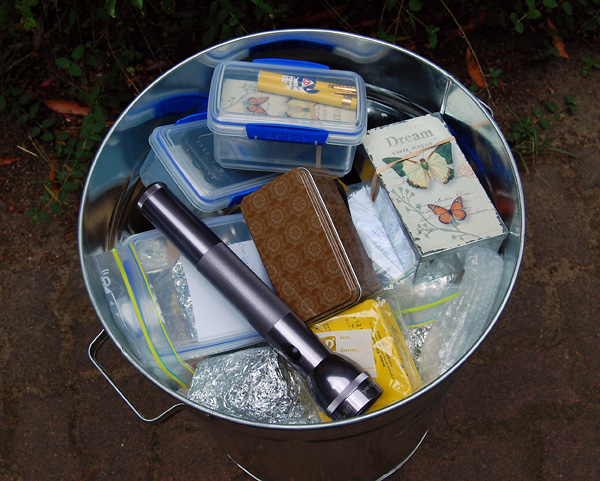
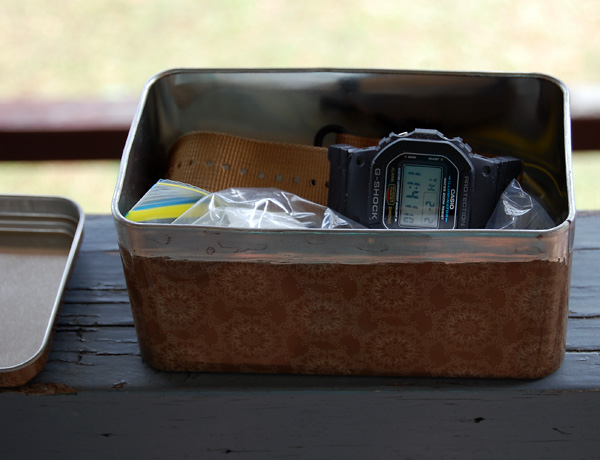
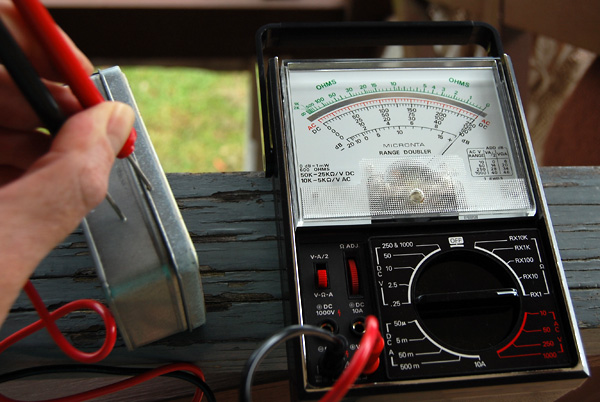
 This box is quite small and can be easily carried. It even has a relaxing picture of flowers on the lid.
This box is quite small and can be easily carried. It even has a relaxing picture of flowers on the lid.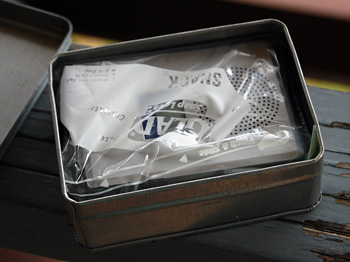 It contains a small battery powered radio. Apart from the obvious uses for a radio, one of its immediate uses would be simply to see if there are any local radio stations still operating — which would be a good indication of whether or not a large disruption such as an EMP has occurred.
It contains a small battery powered radio. Apart from the obvious uses for a radio, one of its immediate uses would be simply to see if there are any local radio stations still operating — which would be a good indication of whether or not a large disruption such as an EMP has occurred.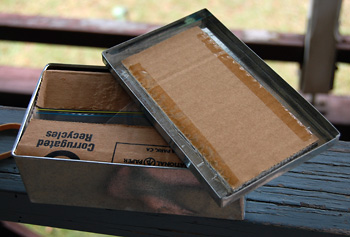 A metal box can be lined with insulating material as shown here using cardboard. Note that the insulation must not prevent electrical contact between the lid and box all the way around. Alternatively, care can be taken to wrap items in plastic or otherwise prevent electrical contact between the inside of the metal box and the item.
A metal box can be lined with insulating material as shown here using cardboard. Note that the insulation must not prevent electrical contact between the lid and box all the way around. Alternatively, care can be taken to wrap items in plastic or otherwise prevent electrical contact between the inside of the metal box and the item.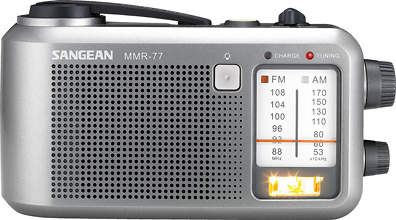
 The seven-minute-long artificial aurora created by the Starfish Prime high-altitude nuclear test explosion on July 9, 1962 as seen through a thick layer of clouds from Honolulu, 1445 km away.
The seven-minute-long artificial aurora created by the Starfish Prime high-altitude nuclear test explosion on July 9, 1962 as seen through a thick layer of clouds from Honolulu, 1445 km away.




